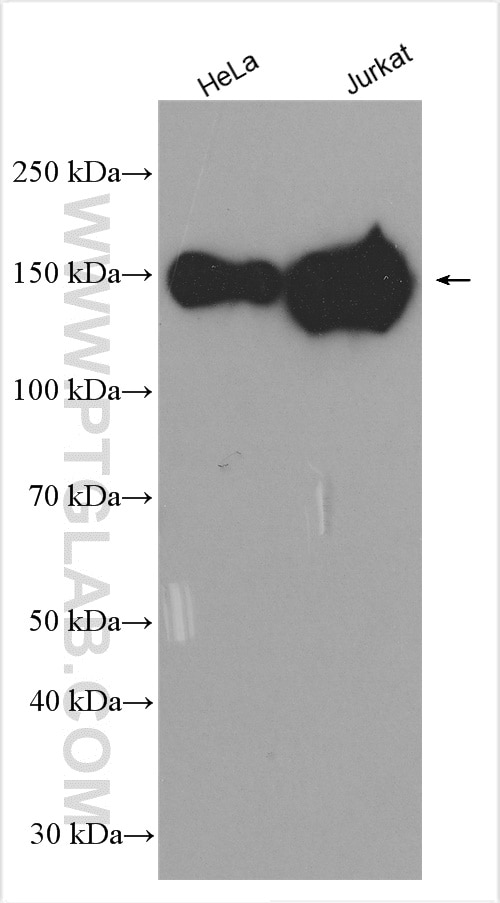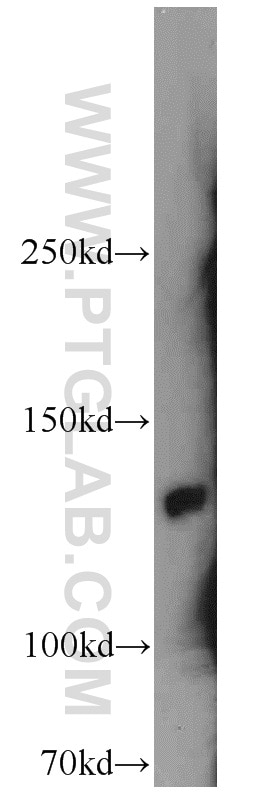- Featured Product
- KD/KO Validated
SRRM1 Polyklonaler Antikörper
SRRM1 Polyklonal Antikörper für WB, IP, ELISA
Wirt / Isotyp
Kaninchen / IgG
Getestete Reaktivität
human, Maus, Ratte
Anwendung
WB, IP, CoIP, ELISA
Konjugation
Unkonjugiert
Kat-Nr. : 12822-1-AP
Synonyme
Geprüfte Anwendungen
| Erfolgreiche Detektion in WB | Mauslebergewebe, HeLa-Zellen, Jurkat-Zellen |
| Erfolgreiche IP | HeLa-Zellen |
Empfohlene Verdünnung
| Anwendung | Verdünnung |
|---|---|
| Western Blot (WB) | WB : 1:500-1:1000 |
| Immunpräzipitation (IP) | IP : 0.5-4.0 ug for 1.0-3.0 mg of total protein lysate |
| It is recommended that this reagent should be titrated in each testing system to obtain optimal results. | |
| Sample-dependent, check data in validation data gallery | |
Veröffentlichte Anwendungen
| KD/KO | See 1 publications below |
| WB | See 2 publications below |
| CoIP | See 1 publications below |
Produktinformation
12822-1-AP bindet in WB, IP, CoIP, ELISA SRRM1 und zeigt Reaktivität mit human, Maus, Ratten
| Getestete Reaktivität | human, Maus, Ratte |
| In Publikationen genannte Reaktivität | human |
| Wirt / Isotyp | Kaninchen / IgG |
| Klonalität | Polyklonal |
| Typ | Antikörper |
| Immunogen | SRRM1 fusion protein Ag3513 |
| Vollständiger Name | serine/arginine repetitive matrix 1 |
| Berechnetes Molekulargewicht | 904 aa, 102 kDa |
| Beobachtetes Molekulargewicht | 120-160 kDa |
| GenBank-Zugangsnummer | BC036187 |
| Gene symbol | SRRM1 |
| Gene ID (NCBI) | 10250 |
| Konjugation | Unkonjugiert |
| Form | Liquid |
| Reinigungsmethode | Antigen-Affinitätsreinigung |
| Lagerungspuffer | PBS with 0.02% sodium azide and 50% glycerol |
| Lagerungsbedingungen | Bei -20°C lagern. Nach dem Versand ein Jahr lang stabil Aliquotieren ist bei -20oC Lagerung nicht notwendig. 20ul Größen enthalten 0,1% BSA. |
Hintergrundinformationen
SRRM1, also named as SRM160 and POP101, contains one PWI domain and belongs to the splicing factor SR family. As part of pre- and post-splicing multiprotein mRNP complexes, SRRM1 is involved in numerous pre-mRNA processing events. It promotes constitutive and exonic splicing enhancer (ESE)-dependent splicing activation by bridging together sequence-specific (SR family proteins, SFRS4, SFRS5 and TRA2B/SFRS10) and basal snRNP (SNRP70 and SNRPA1) factors of the spliceosome. SRRM1 stimulates mRNA 3'-end cleavage independently of the formation of an exon junction complex. It binds both pre-mRNA and spliced mRNA 20-25 nt upstream of exon-exon junctions. SRRM1 binds RNA and DNA with low sequence specificity and has similar preference for either double- or single-stranded nucleic acid substrates. SRRM1, a protein of high molecular weight(120-160kd), has a heavy glycosylation level and is normally highly phosphorylated. This antibody is a rabbit polyclonal antibody raised against residues near the N terminus of human SRRM1.
Protokolle
| PRODUKTSPEZIFISCHE PROTOKOLLE | |
|---|---|
| WB protocol for SRRM1 antibody 12822-1-AP | Protokoll herunterladen |
| IP protocol for SRRM1 antibody 12822-1-AP | Protokoll herunterladen |
| STANDARD-PROTOKOLLE | |
|---|---|
| Klicken Sie hier, um unsere Standardprotokolle anzuzeigen |
Publikationen
| Species | Application | Title |
|---|---|---|
Cell Host Microbe Quantitative phosphoproteomics reveals extensive cellular reprogramming during HIV-1 entry.
| ||
Biochim Biophys Acta Mol Cell Res Cleaved PGAM5 dephosphorylates nuclear serine/arginine-rich proteins during mitophagy. | ||
Tissue Cell SRRM1 promotes the proliferation, migration, and invasion of hepatocellular carcinoma cells by regulating the JAK/STAT signaling pathway |







